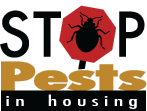- HOME
- » PEST SOLUTIONS
- » Birds
Birds
How to deal with birds
 |
|
Downy woodpecker. Photo by Wendy VanDyk Evans, Bugwood.org. |
 |
|
House sparrow. Photo by John J. Mosesso, National Biological Information Infrastructure, Bugwood.org. |
 |
|
European starling. Photo by Lee Karney, US Fish and Wildlife Service, Bugwood.org. |
If someone nearby is feeding these birds, try to convince them to stop. Cover fruit bushes with netting—buy it at your garden center. Make the places they land on less appealing with netting, bird spikes, or coils. Find suppliers online: search for "bird exclusion" products. Keep birds out of buildings by making sure screens are intact and covering chimneys in the summer. Block entry anywhere you see them getting in.
For woodpeckers, fill holes that have been started asap and put up something that moves in the wind to scare them off. Aluminum foil strips or wind catchers blowing in the breeze near where the damage was found should solve the problem.
What they look like
Pigeons, starlings, and sparrows are the usual suspects in urban settings. Look and listen for signs. If bird droppings, looking like splotches of dirty white paint, build up in places you'd rather they didn't, look up—there's probably a bird-friendly spot up above.
Woodpeckers are a special case, since you're unlikely to find them in urban neighborhoods. If you hear them rapping on the side of your house, look for holes. They're making a nest, drumming a message to other woodpeckers, or looking for food. In which case be grateful—they've alerted you to the bugs that got into the wood.
Where they live
They like to nest or hang out where we live, just up one level.
What they do
Bird droppings can damage whatever they land on, even stone or concrete. Birds carry mites and other parasites and some diseases; some endanger livestock. They play an important role in nature, eating tons of insects. So the goal is to keep them in nature rather than in your building. Woodpeckers can damage wooden buildings.
Resources
Internet Center for Wildlife Damage Management
Damage Management page on Birds
See results from the Northeastern IPM Center's resources database.
